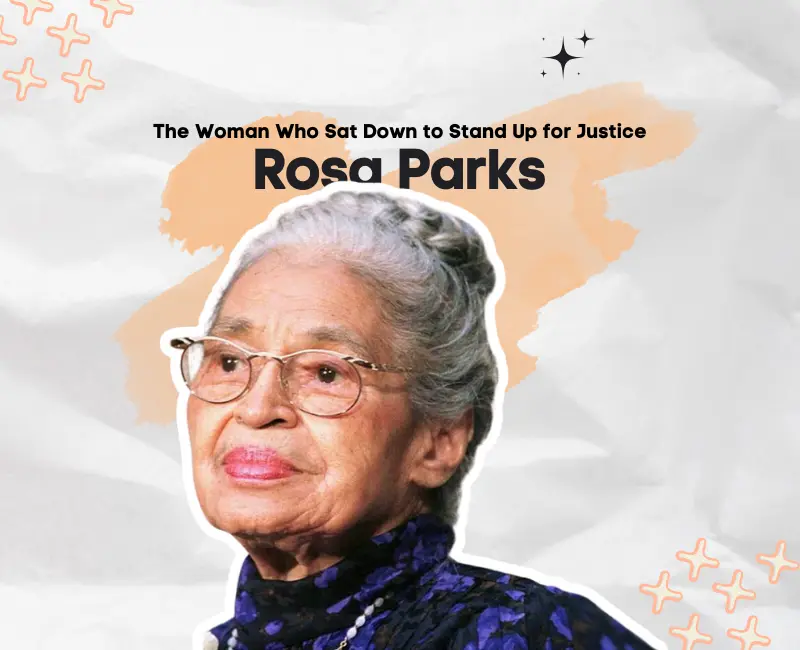Rosa Parks: The Woman Who Sat Down to Stand Up for Justice

History is filled with moments that change the course of human events, but sometimes, it’s the quiet courage of one person that ripples through society and ignites a movement. Rosa Parks is one such individual. Known as the “Mother of the Civil Rights Movement,” Parks’ refusal to give up her seat on a segregated bus in Montgomery, Alabama, became the catalyst for a revolution in America’s pursuit of racial equality. But who was Rosa Parks beyond that single defining moment? Let’s explore her life, her impact, and the legacy that continues to inspire generations.
The Early Years of Rosa Parks
Born Rosa Louise McCauley on February 4, 1913, in Tuskegee, Alabama, Rosa’s early life was marked by the harsh realities of a racially segregated society. Her parents, Leona, a teacher, and James McCauley, a carpenter, separated when Rosa was young. She moved with her mother and brother to Pine Level, Alabama, to live with her grandparents.
Growing up, Rosa witnessed the pervasive discrimination faced by African Americans in the South. The Ku Klux Klan terrorized Black communities, and Jim Crow laws institutionalized racial segregation in every aspect of public life, from schools to transportation. Rosa’s grandparents, both former slaves, instilled in her a sense of dignity and resistance. Her mother emphasized the importance of education, a value Rosa carried throughout her life.
Despite these teachings, the opportunities available to young Rosa were limited. She attended a segregated school system, often walking miles because school buses were reserved for white children. Yet Rosa persevered, showing an early determination that foreshadowed her later acts of defiance.
A Life of Quiet Strength
In 1932, Rosa married Raymond Parks, a barber and active member of the NAACP (National Association for the Advancement of Colored People). Raymond encouraged Rosa to complete her high school education, which she did, becoming one of only a small percentage of African Americans to graduate at the time.
Rosa soon joined the NAACP herself, becoming deeply involved in the fight against racial injustice. She worked as a secretary for the Montgomery chapter, documenting cases of racial violence and discrimination. One notable case was that of Recy Taylor, a Black woman who was gang-raped by six white men in Alabama. Rosa played a key role in bringing national attention to Taylor’s case, demonstrating her commitment to justice long before her famous bus ride.
The Day That Changed Everything
Sometimes, history pivots on an ordinary day. For Rosa Parks, December 1, 1955, began like any other. After finishing her work as a seamstress, she boarded a Montgomery city bus to head home. The buses in Montgomery were segregated, white passengers sat in the front, Black passengers in the back, and a middle section was reserved for overflow. If the bus became crowded, Black passengers were expected to give up their seats to white passengers.
Rosa found a seat in the middle. As the bus filled up, the driver demanded that she and three other Black passengers vacate their seats for white riders. While the others complied, Rosa refused. Her voice, calm and firm, carried a simple but seismic message: “No.”
This act of defiance was not impulsive. Rosa later explained that she was not physically tired, as many assumed, but tired of giving in. Tired of being treated as less than human. She was arrested for violating Montgomery’s segregation laws, and news of her arrest spread like wildfire.
The Montgomery Bus Boycott: A Community United
Rosa’s arrest became the catalyst for one of the most significant movements in American history, the Montgomery Bus Boycott. African Americans, who made up the majority of bus riders, organized a boycott under the leadership of young pastor Dr. Martin Luther King Jr., whose inspiring speeches and vision of nonviolent resistance galvanized the community. For 381 days, they refused to ride city buses, crippling the transit system’s finances and sending a powerful message about the strength of collective action.
The boycott wasn’t easy. People walked miles to work, carpooled, or found creative ways to navigate their daily lives without public transportation. It was a sacrifice that underscored the community’s deep commitment to justice and equality. The solidarity was awe-inspiring, but the movement faced relentless challenges. Protesters were harassed, homes of leaders like Dr. King were bombed, and arrests were frequent as authorities sought to dismantle the protest. Yet, the community’s resolve remained unshaken, fueled by a shared determination to dismantle the unjust system of segregation.
Finally, on November 13, 1956, after more than a year of unyielding perseverance, the U.S. Supreme Court ruled that segregation on public buses was unconstitutional. Rosa’s simple and quiet stand sparked the boycott and led to a monumental victory for civil rights, proving that change was possible through unity, resilience, and the courage to demand justice.
Life After the Boycott
While the bus boycott made Rosa Parks a household name, her life after 1955 was far from a victory lap. She faced constant threats, lost her job, and eventually moved to Detroit with her husband in search of a safer and more stable life. In Detroit, Rosa continued her activism, working for Congressman John Conyers and advocating for housing, education, and criminal justice reform.
Rosa also co-founded the Rosa and Raymond Parks Institute for Self-Development, which focused on educating young people about civil rights and leadership. She authored books, gave speeches, and remained a steadfast voice for justice until her passing in 2005.
Rosa Parks Was No Accidental Hero
Many narratives paint Rosa Parks as a weary seamstress who spontaneously decided to resist, but this oversimplification does her legacy a disservice. Rosa was a seasoned activist, deeply involved in the struggle for civil rights long before her arrest. Her decision to refuse the bus driver’s demand was deliberate and courageous, rooted in years of witnessing and fighting injustice.
Her activism wasn’t confined to that one iconic moment. Rosa fought against sexual violence, helped mobilize voter registration drives, and worked tirelessly to dismantle systemic racism. She was a revolutionary in every sense, though her demeanor was modest.
The Legacy of Rosa Parks
Rosa Parks’ impact extends far beyond her moment of defiance on that Montgomery bus. She became a symbol of dignity and resistance, inspiring countless others to join the struggle for civil rights.
Her legacy is celebrated in numerous ways. In 1996, she received the Presidential Medal of Freedom, the highest civilian honor in the United States. In 1999, she was awarded the Congressional Gold Medal. Schools, streets, and awards bear her name, ensuring that her contributions to justice are remembered.
In 2005, Rosa passed away at the age of 92. Her body lay in honor in the U.S. Capitol Rotunda, a rare tribute typically reserved for presidents and military leaders, underscoring her significance in American history.
What Rosa Parks Taught Us
Rosa Parks’ story is a reminder that change often begins with a single act of courage. Her decision to remain seated wasn’t about a bus or a seat but about the fundamental right to live with dignity. Her life teaches us that resistance doesn’t always look like grand speeches or dramatic actions. Sometimes, it’s as simple and as powerful as saying “no” in the face of injustice.
Her example also underscores the importance of collective action. Rosa’s courage sparked a movement, but it was the collective effort of thousands of people that brought about change. From the foot soldiers who walked to work during the boycott to the legal teams who fought segregation in court, Rosa’s story is a testament to the power of community.
Why Rosa Parks Still Matters Today
As we look at the challenges of the 21st century, systemic racism, inequality, and social injustice, Rosa Parks’ legacy feels more relevant than ever. Her life reminds us that progress is possible but requires vigilance, courage, and a refusal to accept the status quo. Today, the fight for justice continues, as seen in movements like Black Lives Matter, which gained international attention after the tragic death of George Floyd in 2020. Floyd’s death, captured on video, reignited conversations about police brutality and racial inequities, much like Rosa’s quiet defiance on that Montgomery bus forced America to confront the harsh realities of segregation.
At a time when civil rights remain a pressing issue, Rosa Parks’ example serves as a beacon of hope and a roadmap for action. She reminds us that ordinary people, teachers, workers, students, and parents, have the power to challenge oppressive systems through solidarity and persistence. Her legacy is reflected in peaceful protests, calls for criminal justice reform, and campaigns for voting rights that aim to dismantle modern forms of discrimination and inequality.
Conclusion
Rosa Parks may have described herself as an “ordinary person,” but her actions were anything but ordinary. Her quiet defiance on that December day in 1955 was a turning point in American history, proving that one person’s courage can inspire a nation.
As we reflect on her life, let us honor her not just with words but with actions that continue her fight for equality and justice. Rosa Parks didn’t just sit down on a bus; she stood up for humanity. And for that, we owe her a debt of gratitude that echoes through time.


